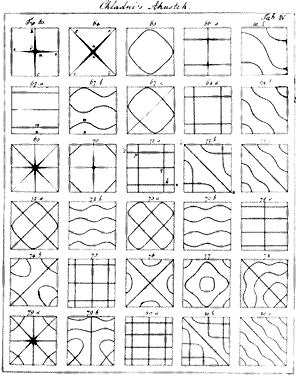| |

|
A Brief History of Cymatics |
| |
Ernst Florenz Freidrich Chladni (1756-1827) - Musician and physicist Ernst Chladni laid the foundation for the discipline in physics that came to be called "acoustics"—the science of sound. His fundamental theories, published in his "Discovery of the Theory of Pitch," have pioneered the basic elements of acoustics, including vibration and pitch.
In 1786, Chladni was able to identify the quantitative relationships governing the transmission of sound, using mathematical analysis to interpret his findings. As the first person to mathematically quantify the relationships governing sound transmission, he came to be known as the Father of Acoustics.
Chladni's experiments consisted of using geometrically shaped, thin glass or metal plates covered with fine sand sprinkled uniformly over the surfaces. He utilized a violin bow to strum along the edge of these plates. The resulting sand patterns illustrated the effects of the vibrations of the violin frequencies. The sand, under the influence of the vibrations of these sound frequencies, moved from the antinodes, collecting symmetrically in nodal lines, forming intricate patterns.

Chladni proved that the pressure derived from sound waves affects physical matter. His documentation was so detailed that, [by] following his methods, the effects of his experiments are reproducible even today. His diagrams depicting the sound patterns derived from these experiments have come to be called Chladni Figures.
Chladni also studied the pitch of sound by measuring the changes in frequency that occur in a gas-filled cylinder. Using an organ pipe filled with gas, he was able to show that the pitch of sound is dependent upon the molecular structure of the gas through which it propagates.[1] |
| |
|
|
| >> HOME |
| |
go to main page |
| >> SOUNDSCAPES |

|
Listen to LucidQuest's specialized audio technology |
| >> LINKS |

|
Browse the Link Gallery |
| >> BOOKS |
| |
Find books to expand your knowledge and wisdom |
| >> GALLERY |
| |
desktop wallpaper, fractals, geometry and art |
| |
| |
|
|

